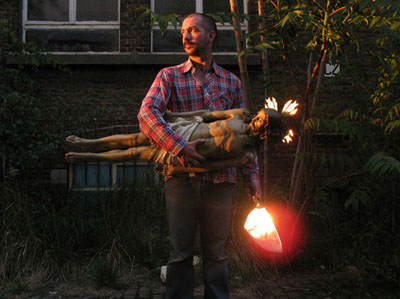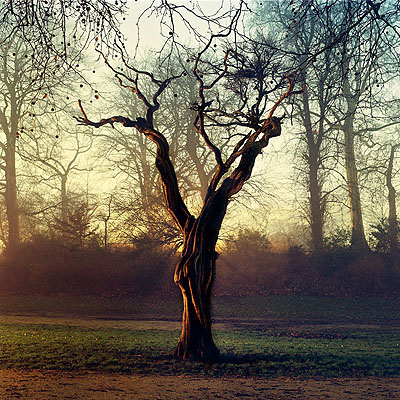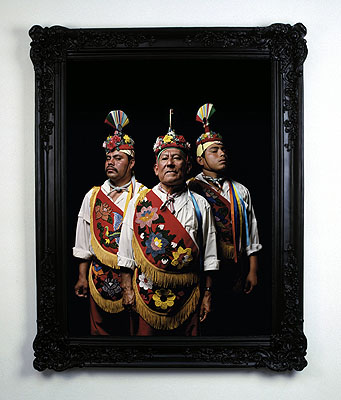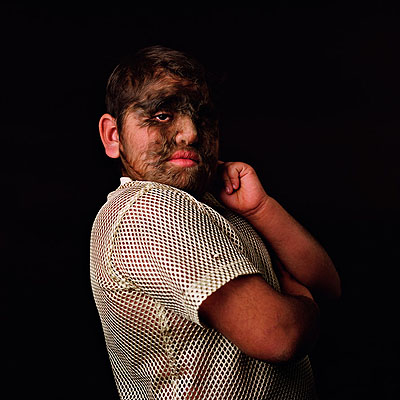
Carlos Aires »
A Day without Sunshine is like Night
Exhibition: 23 May – 14 Jul 2007
AEROPLASTICS contemporary
32, rue Blanche
1060 Brussels
AEROPLASTICS contemporary
rue Vanderkindere str 207
1180 Brussels
+32(0)2-5372202
They lived happily ... It was during his one-year stay in the Midwest in 2004 (Colombus, Ohio) that Carlos Aires suddenly became aware, like so many other expatriates, of the central role played by the computer in our everyday management of information and communication. Messages, chats, forums, online press, photo albums, research and entertainment: everything ended up in one way or another on the screen of his portable. The paradox of the Internet (or its richness, depending on how you look at it) lies in its ability to provide, at the same time, information and the means to dissect it. And a chance to notice the gulf which sometimes (often?) separates data from their sources – for instance, the gulf the article boasting of the merits of American soldiers in combat and the clandestine video placed online by a marine which reveals the crude reality of the war in Iraq (we will come back to this). According to Carlos Aires, behind every truth on which official history is based is another kind of truth; behind every winner is a loser, and behind every fairytale prince is a dwarf. Under the generic title Happily Ever After, these great photographs summarise his outlook perfectly: while everybody is convinced that these small persons are disguised for the occasion, even though this is not true (they are simply displaying their social status and profession), nobody notices that the "fake" side is the décor, these heavy black frames which in fact were moulded by the artist from plastic resin. Apart from the irony-tinged homage to the Spanish 17th century masters, the series questions our ability to manipulate stereotypes and to separate the real from the fake – and underlines the ambiguity of the frames, the bourgeois symbol par excellence which is always excluded from official art history book. The fake hunting trophies, also made from plastic, which carry the signature of the author, form part of the same approach – unless this is an allusion to the expression ¡ cabrón !, the translation of which varies considerably depending on the context. Still in relation to the Happily Ever After series, Carlos Aires took lingering photographs at night of parks known as meeting places for the gay community. The result is a complete transfiguration of these places regarded as sordid by some and as the setting for fantasy films by all. Based on the observation that there are always several visible realities, Carlos Aires wondered about the way in which those born blind can perceive them. First he produced a compilation of very short videos all linked by the theme of death or war. Some come from the Internet, placed online almost illegally by the direct protagonists – such as the images filmed by American soldiers in Iraq. But Carlos Aires has blurred them to the extent that they are almost indescribable to those who can see: hence the title Cataract. In the final version, these sequences are peppered with comments by people born blind who deliver their experiences of death and violence or, rather, the "image" they have of this. The panel paintings using goldleaf, like contemporary icons on triplex, are more complex in terms of their relationship to the net. The images are drawn from Internet chatrooms where each person can hide behind whatever name he wishes: his dog or the disguise of Captain America. Carlos Aires adds an audio comment to each painting, the one incorporated by the user into the web page. The result is a constellation of strangers on the wall: a golden monument to solitude and virtual encounters. Another monument, one consisting of huge knives (so these objects do exist outside horror films?), on which images cut from archive photographs are engraved, while the empty matrix faces them. What is the meaning of a character suspended in space, if he cannot be placed in the context of a fatal fall? Of a child waving a flag, if he is removed from the Nazi parade he is taking part in? Of a person kneeling, if the crematorium oven over which he is leaning has disappeared? Once again, Carlos Aires plays with what you can see, what you cannot see and what is suggested. The same principle applied to pop culture produces vinyl records (preferably "love and dance" music) cut out using a digital process to adopt shapes drawn from mages of disasters or pornography. With, all the same, a happy ending (in this case, a happy beginning): while Mister Hyde I, shot in infrared, combines very ambiguously images of backrooms and very familiar views of fairground stalls (like those in a horror film), Mister Hyde III consists of slow-motion scenes of reunions at an airport: filmed very close-up, the protagonists do not notice at any time the camera filming them – or perhaps in the midst of their emotion, in one of the few public places where this kind of thing is still accepted, they choose not to see it? Chez Carlos, the dwarfs' bar Despite the neon sign in the form of an artist's signature, the official name of the "Aires" bar is Alter Ego – which throws some light on the founder's approach, but requires a few explanations. By dint of working with small people, the question naturally arises as to their relationship with the rest of the world in everyday life: on this basis, Carlos Aires developed his bar as an ironic metaphor for his relationship with the contemporary art world, the critics, curators, collectors and gallery owners, before whom you must kneel to receive approval… thus the visitors, bending down before the dwarf barman, can feel, during the time it takes them to drink a glass of Spanish champagne, the humility required by an artist to draw attention to his work. Or simply the pleasure of having a drink to forget all about it. Pierre-Yves Desaive

Public "cruising park" where homosexuals and prostitutes have sex. StadPark, Antwerp, Belgium
2007
125 x 125 cm (framed) ed. 1/6
Lambda print on aluminium and matt protection layer. black wooden frame

"Voladores" de Mexico (3 generations of acrobats)
2007
174 x 142 x 12 cm ed. 1/6
Lambda print on aluminium and matt protection layer. polyurethane frame.

"wolf" kid, Mexico
2007
125 x 125 cm (framed) ed. 1/6
Lambda print on aluminium and matt protection layer, black wooden frame